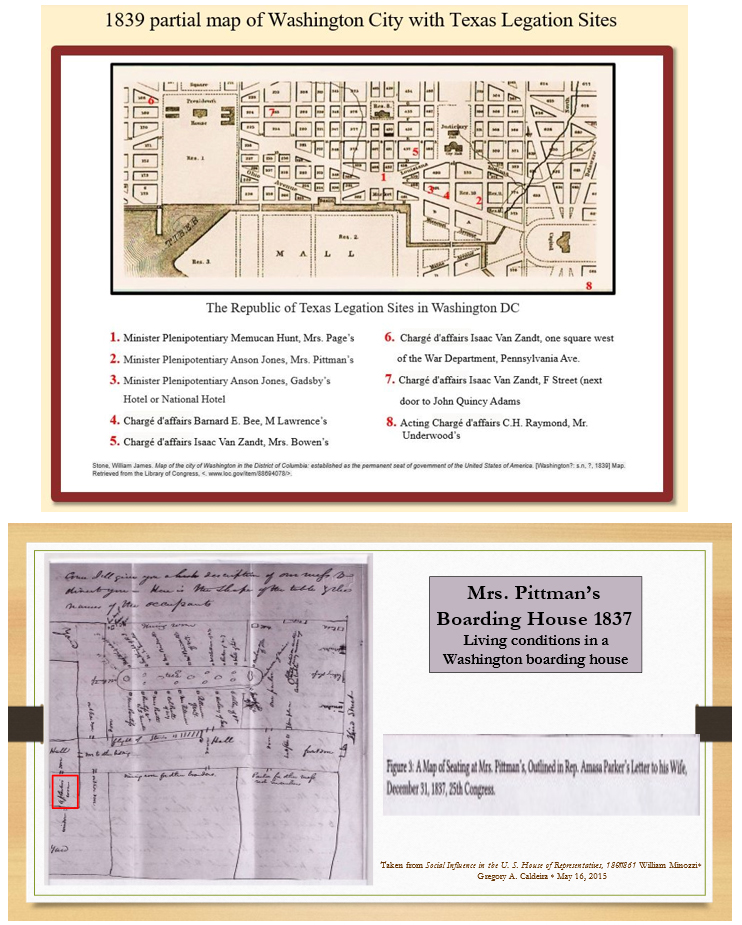Texas Diplomats in Washington City
Leaving Texas to come to work in Washington City was a hardship for the Texas diplomats. Often the ministers had to fund their operations themselves and wait to be reimbursed. Charges D’Affairs Isaac Van Zandt’s trip from Texas to Washington required the use of “a carryall (buggy) drawn by a good team of horses,” “steamboat, stagecoach, sleigh and train.” When Van Zandt’s family arrived in Washington sometime later, they stayed in Alexandria, Virginia a few months. In KM Van Zandt’s autobiography (Isaac Van Zandt’s son) he writes, “I expect my father wanted to rub some of the country off of us before taking us into Washington.”
When members of the Republic of Texas Diplomatic Corp arrived in Washington City, the United States Capital was a small developing city. The major avenues, streets and squares were already laid out but not completed. The streets were dusty dirt or muddy with ruts. The main avenue, Pennsylvania Avenue, ran from the Presidents House to the Capitol Building. The bustling Center Market was located halfway between the Capitol and the Presidents house. Behind the Center Market was a canal that was used to transport goods to and from the Potomac River. The smell was recorded as quite unpleasant. In later years, the canal would be covered over. It is still flowing underneath Constitution Avenue.
The men of the Texas Legation lived in boardinghouses as did senators, congressmen and others who worked in Washington City temporarily. The boarding houses that the diplomatic ministers from the Texas Republic lived in were considered the official Legation Sites.
Boarding house life was difficult in Washington City. James Reily writes to friend Isaac Van Zandt, October 2, 1843, (both Texas diplomats at separate times), “Are you still at Mad. Bowen’s, alias ‘Starvation Hall’ as it is appropriately styled.” Van Zandt writes back October 10, 1843, “The Government starves all its ministers…” and “I view their conduct inexcusable in not paying their foreign ministers promptly.” Acting Minister Chas H. Raymond writes, “Grubb ‘riz’ to $6 and I can’t stand it. Tomorrow, I leave for old quarters at Madam Bowen’s. I have taken the room formerly occupied by the Doct. at $4 per week.”

Minister Anson Jones boarded at Mrs. Pittman’s boarding house, “w side 3w btw Pennsylvania av and Cn, near cen.” as the address was written in the City Directory. The sketch above is a drawing made by another boarder, Congressman Amasa Parker, for his wife in 1837. Minister Anson Jones stayed there in 1839. The boarding house is made from connected buildings, “the dining room and parlor for members of Congress and their spouses are separate from other boarders. This arrangement permitted members to conduct political business over meals and to meet guests in relative privacy.” “Expectations of privacy were quite different in the 19th century, and it was not unusual even for wealthy people to have friends, family or associates live with them for extended periods of time.” In 19th century boarding houses, “Customers of every social class showed up and took whatever accommodation that happened to be available.” “A gentleman might find himself shoulder to shoulder with a member of a ‘lower order’ at the dinner table and then body to body in a bed upstairs.”

